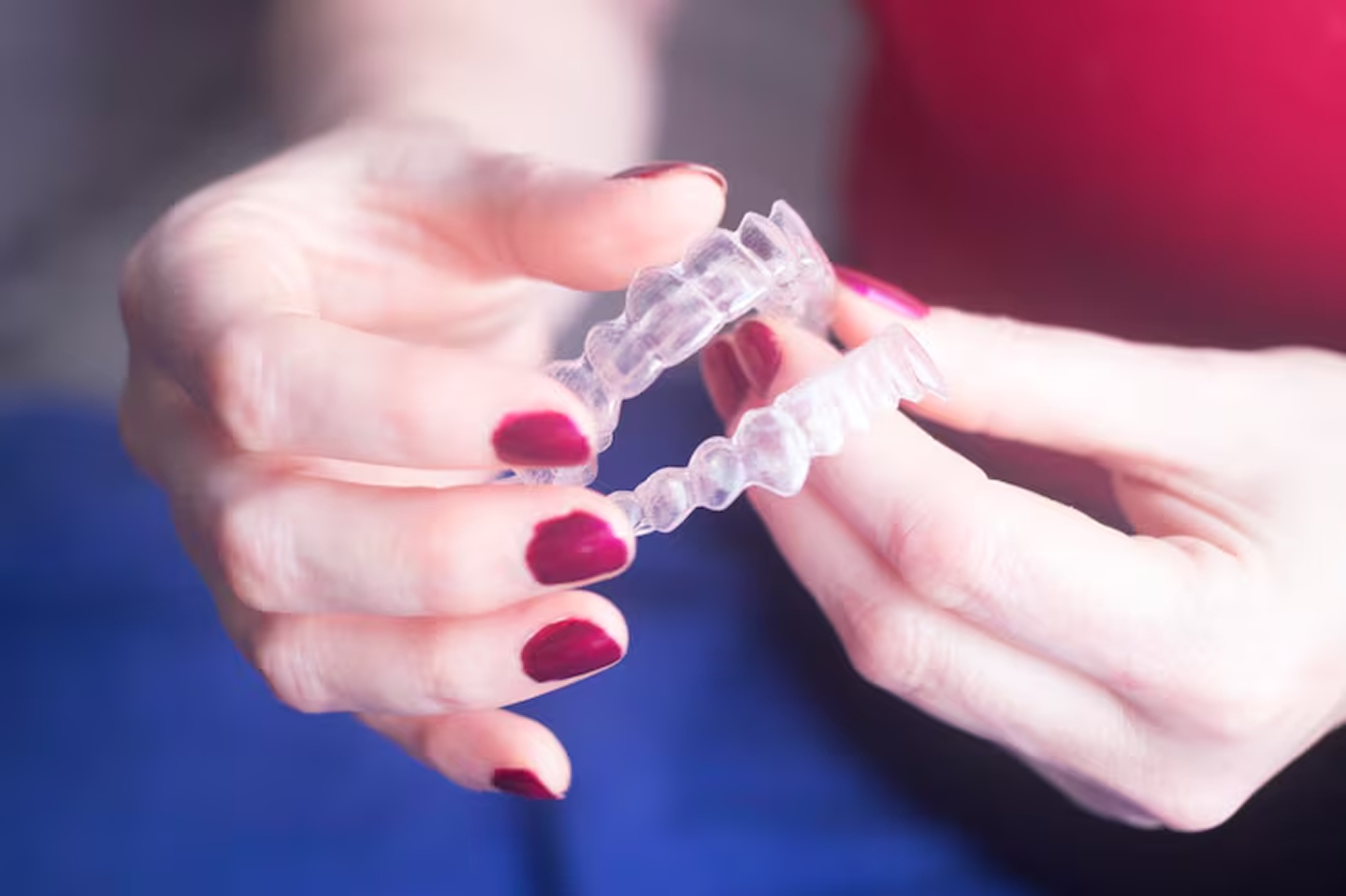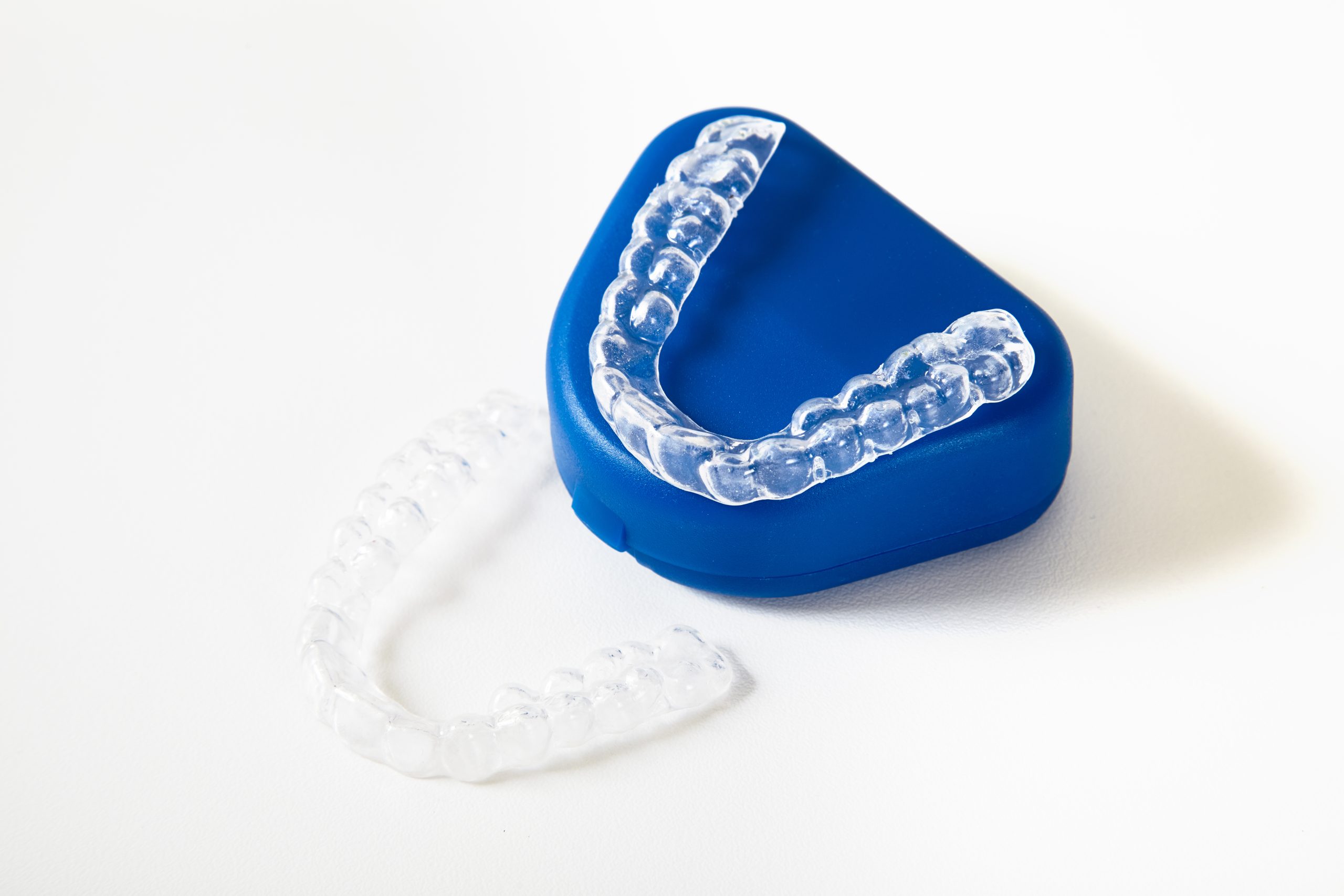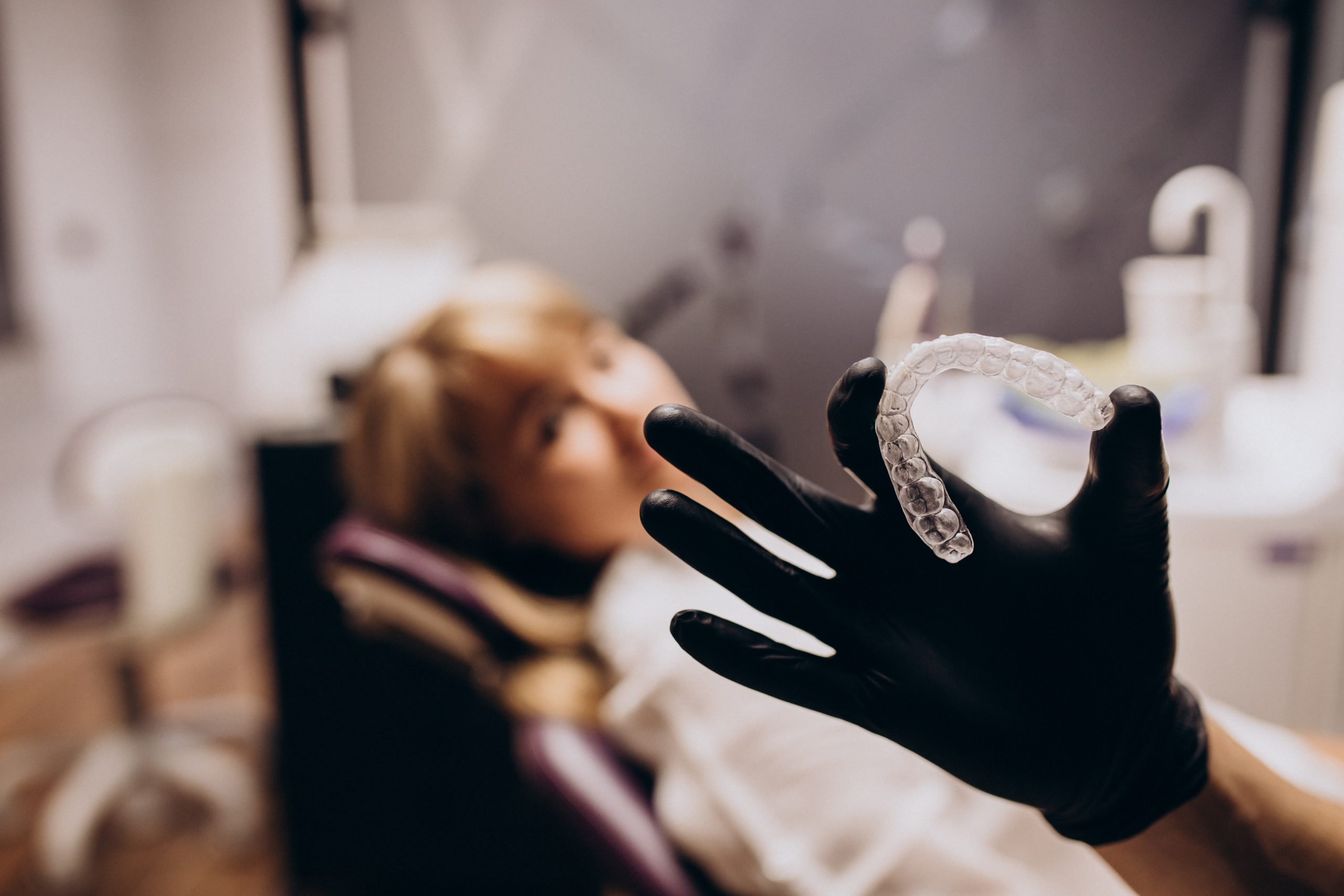Invisalign is a popular orthodontic treatment that gradually shifts teeth using a series of clear aligners. While it offers a comfortable alternative to traditional metal braces, mild discomfort can occur as the mouth adjusts to the aligner trays. This temporary discomfort is a normal straightening process and usually decreases over time.
Understanding how to manage Invisalign-related pain can make the treatment more comfortable. Simple adjustments, such as using Invisalign pain relief strategies and maintaining good oral hygiene, can help ease Invisalign pain. Patients can confidently continue their Invisalign journey by knowing what to expect and how to minimise discomfort.
Contents Navigation
Summary of the Content:

- Mild discomfort is expected as Invisalign aligners gradually shift teeth.
- Pain usually decreases after a few days as the mouth adjusts to new aligners.
- Using a cold compress, drinking cold water, or sucking on ice cubes can help ease discomfort.
- Eating soft foods instead of hard, crunchy, or sticky foods can prevent unnecessary pain.
- Brushing, flossing, and cleaning aligners regularly help maintain dental health and reduce irritation.
- Orthodontic wax can be applied to sharp aligner edges to prevent gum and cheek irritation.
- Wearing aligners as directed helps teeth move properly and avoids unnecessary discomfort.
- If pain lasts beyond a few days or worsens, consulting a dentist may be necessary.
What to Expect from Invisalign Treatment
Patients starting Invisalign should expect an initial adjustment period as their teeth and gums adapt to the aligners. The first few days of wearing a new set of aligners may bring mild discomfort, gum pain, or tooth sensitivity. This occurs because the aligners gently pressure the teeth to encourage movement. Practising Invisalign pain management can help ease this initial discomfort and make the transition smoother.
As the mouth adjusts, the discomfort experienced will gradually lessen. Some may feel soreness around certain teeth, while others notice pressure on their jaw. These sensations are temporary and usually subside within a few days. Switching to a new aligner before bed can help patients sleep through the most noticeable pressure.
Unlike traditional braces, Invisalign trays do not have brackets or wires that cause mouth sores. However, aligner edges can occasionally irritate the cheeks or tongue. If this happens, orthodontic wax can be applied to reduce discomfort. Regular dental check-ups also help monitor progress and address persistent pain or sore spot concerns.
Understanding Invisalign Discomfort
Invisalign aligners apply gentle pressure to straighten teeth, which can lead to temporary discomfort. Patients may notice mild pain when switching to a new aligner as their teeth and gums adjust. This sensation usually decreases within a few days, but some may experience gum inflammation, tooth sensitivity, or jaw pain.
For most, discomfort experienced during Invisalign treatment is manageable. Simple adjustments like using a cold compress or drinking cold water can help ease Invisalign pain. If severe or persistent pain continues beyond the initial adjustment period, seeking professional advice may be necessary.
Causes of Invisalign Pain
Several factors contribute to Invisalign-related pain, particularly during the early stages of treatment. Understanding these causes can help patients proactively reduce discomfort and avoid unnecessary pain.
- Tooth movement:
Invisalign aligners apply gentle pressure to shift teeth into place. This gradual movement can temporarily increase tooth sensitivity, especially when wearing a new aligner. - Aligner fit:
A new set of aligners may initially feel tight, leading to mild pain as the teeth adjust. If the aligners are not seated properly, they can cause unnecessary discomfort. - Gum inflammation:
Some patients experience mild gum irritation as their mouth adapts to the aligner trays. This can lead to soreness, mainly if the aligners press against sensitive areas. - Sharp edges:
In some cases, the edges of Invisalign trays may feel rough and cause sore spots along the gums or inner cheeks. Using orthodontic wax can help smooth out these areas and prevent further irritation. - Jaw pain:
Constant tooth movements during Invisalign treatment can place pressure on the jaw, leading to temporary discomfort. This may be more noticeable when clenching or chewing.
Since discomfort is a common part of the Invisalign journey, knowing the root causes can help patients manage their symptoms more effectively. Simple adjustments, such as using a cold compress or avoiding crunchy foods, can reduce discomfort and make treatment easier.
Managing Invisalign Discomfort
Adjusting to Invisalign aligners can cause initial discomfort, but there are ways to make the process easier. Simple techniques can help reduce Invisalign jaw pain and alleviate discomfort, allowing patients to continue their treatment with minimal disruption.
While mild soreness is common initially, the right approach can prevent unnecessary discomfort and keep the experience as smooth as possible.
Tips for a Comfortable Treatment
Simple strategies can help manage discomfort and make Invisalign treatment more comfortable.
- Use an ice pack or cold compress:
Applying a cold compress to the outside of the mouth can provide temporary relief and reduce swelling caused by pressure on your teeth. - Drink cold water:
Sipping cold water throughout the day can help counter pain and soothe gum irritation. - Suck on ice cubes:
This can ease Invisalign jaw pain and provide relief from tooth pain without interfering with the aligners. - Avoid eating hard, crunchy foods:
Soft foods are easier to chew and reduce the risk of causing discomfort while wearing Invisalign aligners. - Use over-the-counter pain relievers:
If the pain persists, a mild pain reliever can help manage it and prevent it from recurring. - Maintain proper oral hygiene:
Good oral health can prevent gum irritation and other issues that may worsen Invisalign-related pain. - Stay consistent with aligner wear:
Wearing aligners as instructed helps teeth gradually shift, reducing the likelihood of severe pain from unnecessary delays. - Be mindful of allergic reactions:
While rare, some people may experience irritation from Invisalign trays. If this happens, seeking professional advice is essential.
These strategies can help patients avoid Invisalign pain and support a successful treatment. Effectively managing discomfort allows for a straighter smile without unnecessary pain.
Maintaining Aligner Comfort
Taking care of the aligners plays a key role in Invisalign pain management, helping to minimise discomfort and keep treatment on track.
Proper aligner care can reduce irritation and support a smooth straightening process. Keeping aligners clean and wearing them as directed allows teeth to shift gradually without causing persistent discomfort.
Guide for a Smooth Treatment
Simple habits can improve aligner comfort and help avoid unnecessary pain.
- Check that aligners fit properly:
A secure fit helps prevent discomfort and allows teeth to move as expected, reducing issues with misaligned teeth. - Limit how often aligners are removed:
Taking aligners out too frequently can cause unnecessary discomfort and slow progress. - Start new aligners before bed:
Wearing a new set overnight allows teeth to adjust during sleep, reducing gum pain in the initial stages. - Follow the prescribed schedule:
Sticking to the treatment plan helps prevent persistent discomfort and supports steady tooth movement. - Maintain good oral hygiene:
Regular brushing and flossing prevent plaque buildup, leading to gum irritation and affecting dental health. - Keep aligners clean:
Rinsing and brushing aligners daily prevents bacteria buildup, improving overall comfort.
Following these steps helps alleviate Invisalign discomfort and makes the process smoother.
Diet and Invisalign Treatment
Food choices play an essential role in reducing discomfort during Invisalign treatment. While aligners should be removed when eating, certain foods can still impact dental health and overall comfort. Hard, crunchy, or sticky foods can put extra pressure on teeth, causing unnecessary discomfort. This is especially true when adjusting to a new set of aligners.
Soft foods are a better option, particularly during the initial stages of treatment. Choosing easy-to-chew foods can help alleviate Invisalign discomfort and prevent gum irritation.
Staying hydrated and avoiding overly hot or cold foods can reduce tooth sensitivity. Making mindful dietary choices supports a smoother treatment experience and helps prevent irritation or soreness.
Eating softer foods can make Invisalign treatment more comfortable. These options are gentle on teeth and more straightforward to chew:
- Soft dairy products:
Yoghurt, cottage cheese, and soft cheeses are gentle on teeth and easy to eat. - Cooked vegetables:
Steamed or roasted vegetables like carrots, zucchini, and sweet potatoes provide nutrients without causing discomfort. - Soft proteins:
Scrambled eggs, tofu, and well-cooked chicken or fish are easier to chew and support a balanced diet. - Smooth fruits:
Bananas, avocados, and ripe peaches are easy on teeth and provide natural sweetness. - Grains and starches:
Oatmeal, mashed potatoes, pasta, and soft bread are filling options that won’t pressure teeth. - Soups and broths:
These warm, soothing options provide nourishment without requiring much chewing.
Certain foods can make Invisalign treatment more uncomfortable. Avoiding these can help prevent irritation and unnecessary pain:
- Hard foods:
Nuts, popcorn, raw carrots, and ice cubes can cause discomfort and put extra pressure on shifting teeth. - Crunchy snacks:
Chips, crackers, and hard pretzels may be challenging to chew and lead to soreness. - Sticky foods:
Chewy lollies, caramel, and gum can get stuck in teeth, making cleaning more difficult. - Tough meats:
Steak and jerky require excessive chewing and may cause jaw pain. - Acidic or sugary foods:
Citrus fruits, soft drinks, and lollies can increase tooth sensitivity and affect dental health.
Making mindful food choices can help minimise discomfort and support a successful Invisalign treatment.
Preventing Soft Tissue Irritation
Wearing invisible aligners can sometimes irritate the gums, cheeks, or tongue, especially during the early stages of treatment. This discomfort is usually temporary as the mouth adjusts to the aligners.
However, sharp edges or friction from dental aligners may lead to sore spots or minor irritation. Taking simple steps can help prevent and manage these issues.
- Use orthodontic wax:
Applying orthodontic wax to rough or sharp edges can reduce irritation and prevent further discomfort. - Avoid hard, crunchy foods:
Eating softer foods reduces friction and helps prevent unnecessary irritation inside the mouth. - Rinse with salt water:
A warm saltwater rinse can help soothe sore areas and promote healing. - Stay hydrated:
Drinking plenty of water keeps the mouth moist and reduces dryness that can contribute to irritation. - Maintain proper oral hygiene:
Brushing and flossing regularly helps keep gums healthy and reduces the risk of further discomfort.
By managing irritation early, patients can adjust to their Invisalign treatment more comfortably.
When to Consult Your Dentist
Mild discomfort is expected during Invisalign treatment, especially when adjusting to a new set of aligners. However, some issues may require professional attention.
If pain becomes severe or persistent, seeking guidance can help prevent further complications.
Consider consulting a dentist if:
- Pain persists beyond a few days:
Discomfort should gradually improve as the mouth adjusts to the aligners. If pain continues or worsens after several days, it may indicate an issue with fit or excessive pressure on specific teeth. An adjustment or additional guidance may be needed. - Sores or irritation do not heal:
Minor irritation is common as the cheeks, tongue, and gums adapt to the aligners. However, if sore spots or gum irritation persist, it may be due to rough aligner edges or excessive friction. A dentist can assess the fit and recommend ways to reduce irritation. - Difficulty wearing aligners:
Aligners should fit snugly over the teeth but not cause excessive discomfort. They may need to be checked for fit and positioning if they feel too tight or painful or do not sit properly on the teeth. - Unusual pressure or misalignment occurs:
Some pressure is normal as teeth gradually shift, but if certain teeth feel excessively strained or alignment seems uneven, adjustments may be needed to prevent further discomfort. - Signs of an allergic reaction appear:
Invisalign aligners are made from biocompatible materials, but in rare cases, patients may experience irritation, swelling, or sensitivity. If these symptoms occur, a dentist can determine whether an alternative approach is needed.
If any of these issues arise, consulting a dentist can help keep Invisalign treatment on track and prevent unnecessary discomfort.
Final Thoughts
Invisalign provides a discreet and comfortable way to straighten teeth. However, some mild discomfort is expected as teeth gradually shift.
Knowing how to manage discomfort can make the treatment experience much more manageable. Simple adjustments, such as using a cold compress, maintaining good oral hygiene, and making mindful food choices, can help alleviate Invisalign discomfort.
Most discomfort fades as the mouth adjusts. However, persistent irritation or pain may require professional attention. Staying consistent with aligner wear and following recommended care practices can help keep the process on track.
For those needing guidance on Invisalign pain management, Enso Dental North Perth offers support. Their team provides personalised advice to help patients throughout their Invisalign journey.









